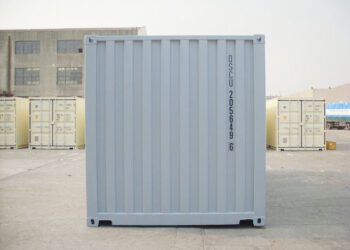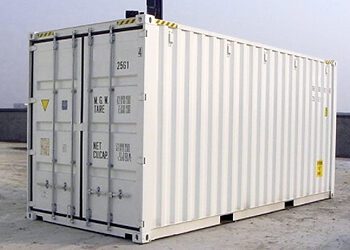Condensation can be a serious problem for shipping containers because it can damage the contents of the container and lead to an unhealthy damaging internal environment. Container rain and container are common names for condensation in storage containers throughout multiple industries. However, if you are having condensation problems in your shipping container, the good news is that there are some things you can do to help prevent and reduce the problem.
When water vapour in the air comes into contact with a cold surface, it condenses and forms water droplets. This can happen when humid air enters a container that is not adequately ventilated or when the temperature inside the container drops suddenly. So it is no surprise that condensation is one of the most common problems with shipping containers.
One of the most common causes of condensation is container humidity levels. When the air is saturated with moisture, it can condense on any cold surface, including the walls and ceiling of a shipping container.
Another common cause of condensation is temperature differences between the inside and outside of the container. When there is a significant temperature difference, the air inside the container will cool down and become denser than the air outside. This can cause water vapour to condense on the walls and ceiling of the container.
Insufficient ventilation can also contribute to shipping container condensation problems. When the air inside the container is not able to circulate, it can become stagnant and start to condense on the walls and ceiling.
Leaks in the shipping container can also cause condensation problems. If there is a hole or crack in the container, moisture can seep in and start to condense on the walls and ceiling.
Items that produce moisture, such as plants, wood, books, mattresses, cardboard, and furniture, can also cause condensation problems. When these items release moisture into the air, they can condense on the walls and ceiling of the container.
Although numerous issues occur when you have a condensation problem in a shipping container, three main problems are prevalent in most cases:
Condensation can cause severe damage to your belongings. The contents of your container may not be waterproof, so the condensation can cause them to be warped and damaged. Some items that are especially prone to becoming damaged by condensation would be electronics, furniture, photos, and leather.
Damp conditions can cause bacteria, mold and mildew to grow inside the container, which creates an unhealthy environment inside the container, which can potentially cause respiratory problems for people who are exposed to them. In addition, these conditions can damage whatever you are storing inside your sea container.
The condensation can cause corrosion and potentially damage the container if it is not maintained. In extreme cases, condensation can even lead to the formation of ice on the walls of the container, making it difficult to open doors and windows.
With the following steps, you will learn some of the top strategies about how to stop condensation in a shipping container and how to keep a shipping container dry.
Try to avoid storing items that are sensitive to humidity inside the container. If you must store things like this, place them in plastic bags or containers with tight-fitting lids. This will help to keep the moisture out and prevent condensation in a closed container.
By keeping the air inside your container dry, you can prevent condensation in a shipping container from forming on the walls and ceiling. If you live in an area with high humidity, you may also want to consider using a dehumidifier for shipping containers. Ensure that you plan the placement for optimal use, maintenance, and access so that you can reduce the humidity inside the container.
One of the best solutions to condensation in shipping containers in dryer climates is to make sure that the container is properly ventilated. You can do this by regularly opening the doors and windows or installing a ventilation system. For example, if your container does not have a window, then adding windows to your container while also installing customized container fans and vents can improve airflow.
Desiccants absorb excess moisture from the air, which reduces the condensation inside the shipping containers. There are various types of desiccants, such as bags, blankets, and pads. Desiccants are some of the best moisture absorbers for shipping containers since they can be placed in multiple locations throughout the inside to absorb container moisture in the air. This step is one of the best ways to reduce condensation in a closed container.
Proper insulation will help to keep the temperature inside your container consistent and warmer than the dew point. This step is important because a constant temperature helps in stopping condensation in shipping containers from forming. In addition, adding special insulation lining a shipping container will help protect the contents of your container from water damage. Another benefit to this step is that keeping a consistent temperature can prevent sensitive items from becoming damaged by unpredictable weather conditions that cause fast temperature changes and humidity.
This step can help you know how to keep moisture out of shipping containers. Taking a few minutes to open up your container to air it out and check for condensation is one of the easiest ways to ensure that you can stay up to date on any maintenance or issues. During your regular checks, be sure to inspect your sea can for rust, leaks, and any significant new dents since your last check.
Condensation in shipping containers can be a serious problem, leading to the growth of mold and mildew and the deterioration of stored goods. Luckily, by implementing these simple solutions to condensation in shipping containers, you can prevent many of the most common problems in climates with high humidity levels or environments with fast-changing weather conditions.
Are you ready to buy a used or new shipping container for personal or business use?
Coast Containers has a large inventory of sea cans for sale across Canada. You can learn more and get a customized quote today.
Not ready to buy a storage container yet?
Our sister company, Make Space Storage has moving and storage services, including portable storage containers, self-storage units, RV/Boat parking spaces, and packing supplies.



